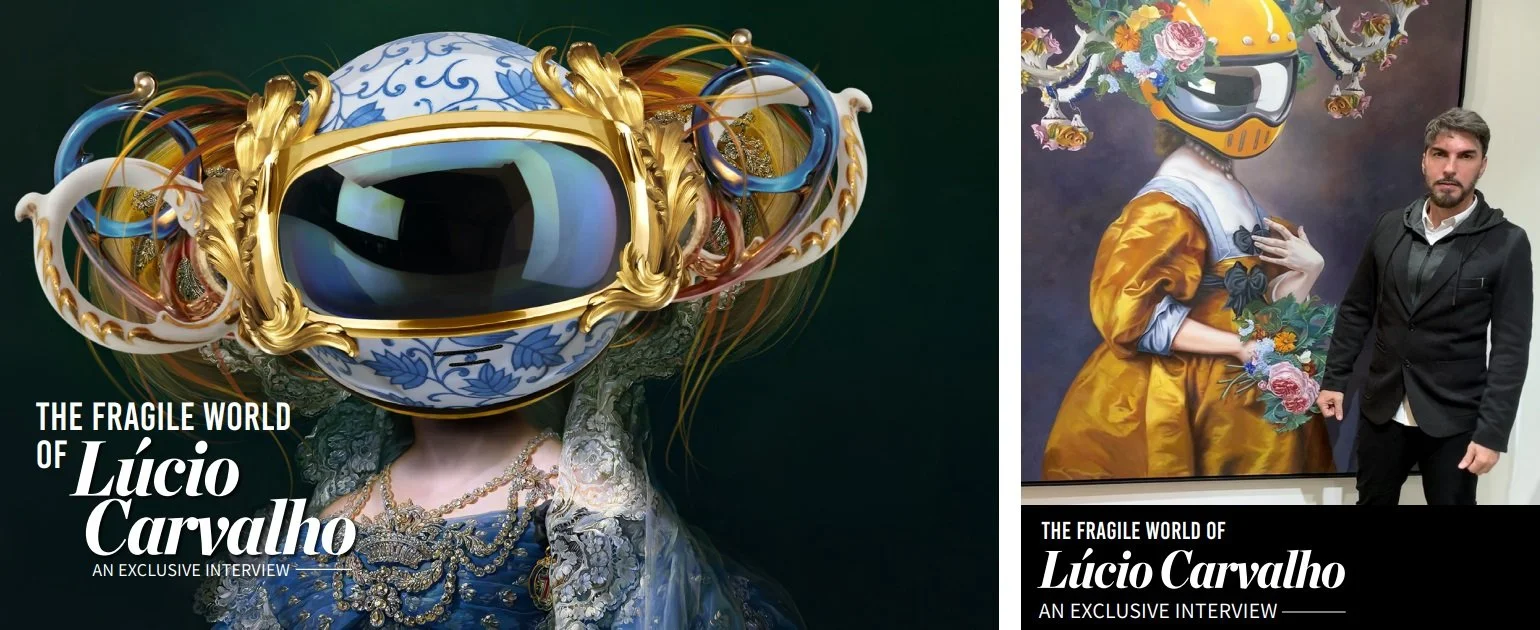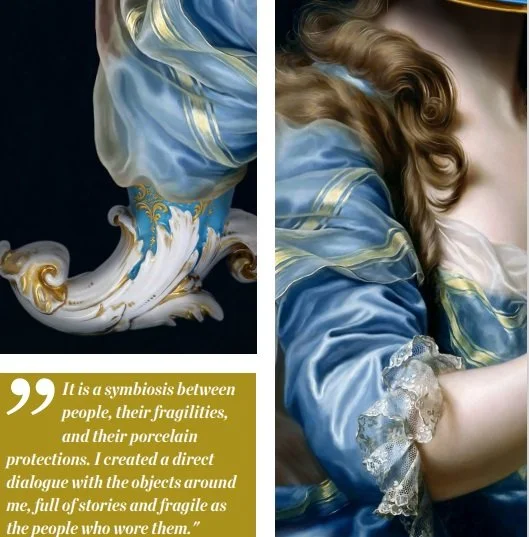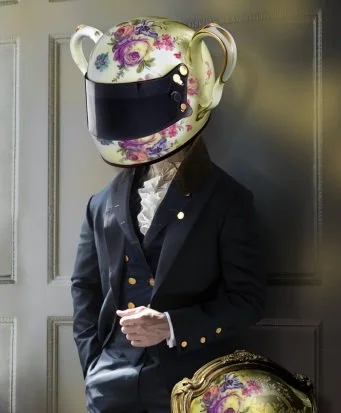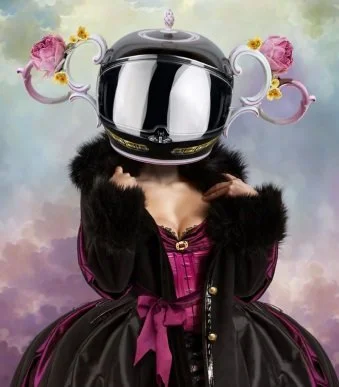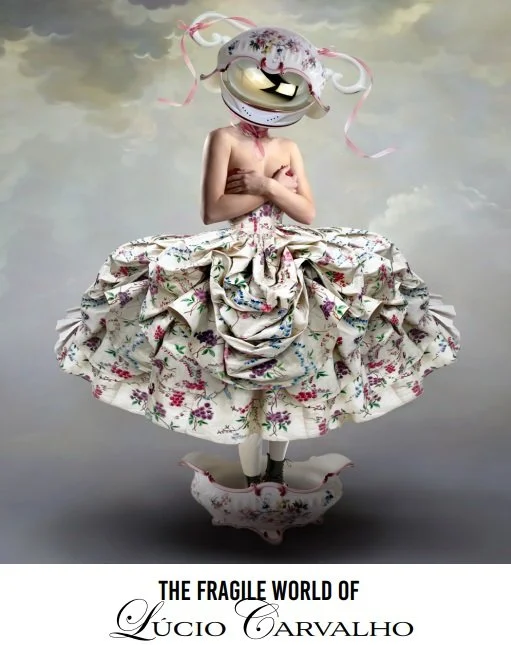An EXCLUSIVE interview with Lucio Carvalho
Lúcio Carvalho's art is inspired by scenography as well as Baroque, Rococo and Renaissance era. Carvalho has been drawn to art for his entire life; as a child, he would find refuge under a huge banquet table, where he would spend his time drawing and coloring, exhibiting his prized possession for his eyes only. For a very long time, Lúcio felt different, guilty, and confused as to why he had such a passion for expressing himself and creating. Paralyzed by the fear of not owning a living, he waited before deciding to follow his passion and make a living as an artist. With an incredibly emotional, high technique, and full of passion for art, Carvalho is the rising star of the contemporary art market. He is represented by Chic Evolution in Art Gallery, and you will discover some of his most significant artworks at Art Basel, Miami, in the upcoming December.
Born in 1965 in Cambucí, a municipality of Rio de Janeiro in Brazil. He graduated in 1986 in Industrial design and drawing at the University of Rio de Janeiro. Till 1997, Carvalho worked in Rio de Janeiro as an artistic director and designer for various advertising agencies. In 1998, he decided to move to São Paulo, where he is still based, to fully dedicate his time to his artistic practice. Since then, his work has been shown extensively in Brazil and internationally in France, Belgium, Germany, USA, Italy, and Japan, at fairs and solo and group exhibitions. In addition, he was awarded several international awards that recognized the quality and inherent excellence of his work. For example, he was amongst the winners of the Interventions in the Guggenheim New York competition in 2010. In addition, he was chosen to be part of the Modern Photographic Exhibition of Brazil created by the Photographic Society of Japan.
ART MARKET MAGAZINE: Dear Lucio, It's a pleasure having an interview with you. We visited your Instagram profile and were very impressed by your unique style, from the idea formed and expressed in your art by high-level technique. Let's start from the beginning. What are your routs in art? Did you come from an artistic family? Did you drown into art by your surrounded family and friends during your childhood?
LÚCIO CARVALHO: My encounter with art was at a pretty late age. I grew up in an agricultural area, my family's farm, far from any urban center, and I didn't have much access to art. I grew up on a centenary farm that belonged to my maternal great-grandparents, a magical place surrounded by nature, animals, and many memories of the past. My cousins, my brother, and all the children on the farm loved to ride horses and play, except for me, I was only interested in drawing, coloring, and painting... It didn't take me long to realize that I'm different, that there's something else in me, not familiar with the place I was living in. I never witnessed other people in my life creating art or showing the same interest in art the same way as me, so I deduced that drawing should be prohibited or something that should be done privately. Since then, I started hiding to draw.
A. M.: Before we talk about your journey in the Art Field, establishing your name through art exhibitions worldwide, Let's discuss your current style, which is highly influenced by the Baroque and Rococo artistic styles. You combine Hyperrealism with a contemporary, modern, dreamy approach in your art, which is unique. Where did the idea come from? What led you to develop this artistic style made by this combination?
L. C.: Having deduced that I was a very different child from the others and due to my uncontrollable addiction to drawing, I started to hide under a huge dining table on the farm, protecting myself from bullying, curious and supposedly repressive looks. Positioned in front of that enormous table, I could see an old wooden china cabinet with cut glass. From hiding under that table, I could observe the crockery and china reflected in the mirrors at the back of the cabinets, a small universe around me. Below, I saw myself in their mirrors that reflected people, portraits, paintings, cups, and teapots mixed together in a magical and unique image. I realized that all those memories and objects stored in the cabinet were as fragile as the beveled glass that protected them.
A. M.: Which artists influenced your work?
L. C.: Many should be mentioned here:
-Nelson Leirner, for the compositions of children, religious, Brazilian, and banal elements that populate his works and my mind.
-Adriana Varejão, for her overflowing and exposed viscerality that so shock, repel, and fascinate me.
-Arthur Bispo do Rosário, for his misunderstood sanity and his logic in reorganizing his private universe.
-Jeff Koons, for his impeccable and dubious aesthetic sense, reminds me so much of my loving memories.
-Matthew Barney, I visited his exhibition at the Palais de Tokyo - Paris in 2002. My first contact with a contemporary artist outside Brazil profoundly transformed my way of thinking. -Caravaggio, For all its drama. His way of playing with light and shadow and its atmosphere hypnotizes me and reminds me of the nights on the farm before installing the electric light.
A. M.: How would you describe the idea behind your art? The shiny masks on the baroque feminine women with such a solid emotional approach... What are you trying to express?
L. C.: It is a symbiosis between people, their fragilities, and their porcelain protections. I created a direct dialogue with the objects around me, full of stories and fragile as the people who wore them. The figures and objects in my paintings came into the world to be shared but were kept there for several generations, so they don't risk being broken. Could it be that in this search for hypothetical protections, we would not be saying: listen to me, look at me here inside this dome, get me out of here, hug me, we can share and celebrate. So let's go out to the world without shields and fear of what comes to happen...
A. M.: Digging a bit through your previous artistic projects, we discovered sculptures, beautiful work mainly based on organic items, combined in golden or shiny skulls, or porcelain items combined with wood. How would you describe these different phases in your art until they reached your current style?
L. C.: "Averses" or "Inside out" is a series that at first seems disconnected from my current creation, as it causes strangeness and repulsion. Still, it also attracts us and instigates us to look inside. This series has precisely the exact origin in that farm of a matriarchal family where I grew up, and because there was no electricity, most women used to spend all their time cooking, so the food did not go wrong. Reflected in the mirrors between the porcelains, I watched the meats smoking amidst the white smoke above the wood-burning stove, almost like a magical ritual.
A. M.: Can you explain the workflow of your art? From the point of the idea to the complete outcome of your work? As I understand, you are usually based on photography, which is later on being painted manually by acrylic and oil color?
L. C.: In the current phase, I started based on research about the great masters of the renaissance, Baroque, Rococo... I took their magical and unreachable characters that fascinated me so much through the history books, transported them to my universe, and then protected them with my fragile porcelain helmets. Currently, I'm gradually detaching myself from these classic and literal paintings and getting closer to a more contemporary context, permanently attached to my affective memories that are the basis of all my work. In my atelier in Brazil, an incredibly lonely and necessary process for creating creation begins. First, this idea is expanded and painted in oil on canvas; with the help of my team. Then, as soon as we finished, we sent it to the art framing place to be appropriately tensioned, varnished, and framed.
L. C.: "Averses" or "Inside out" is a series that at first seems disconnected from my current creation, as it causes strangeness and repulsion. Still, it also attracts us and instigates us to look inside. This series has precisely the exact origin in that farm of a matriarchal family where I grew up, and because there was no electricity, most women used to spend all their time cooking, so the food did not go wrong. Reflected in the mirrors between the porcelains, I watched the meats smoking amidst the white smoke above the wood-burning stove, almost like a magical ritual.
A. M.: Can you explain the workflow of your art? From the point of the idea to the complete outcome of your work? As I understand, you are usually based on photography, which is later on being painted manually by acrylic and oil color?
L. C.: In the current phase, I started based on research about the great masters of the renaissance, Baroque, Rococo... I took their magical and unreachable characters that fascinated me so much through the history books, transported them to my universe, and then protected them with my fragile porcelain helmets. Currently, I'm gradually detaching myself from these classic and literal paintings and getting closer to a more contemporary context, permanently attached to my affective memories that are the basis of all my work. In my atelier in Brazil, an incredibly lonely and necessary process for creating creation begins. First, this idea is expanded and painted in oil on canvas; with the help of my team. Then, as soon as we finished, we sent it to the art framing place to be appropriately tensioned, varnished, and framed.
A. M.: Tell us about the Guggenheim New York competition in 2010, where you have been selected as one of the winners.
L. C.: The prize proposed by GUGGENHEIM, in commemoration of its fiftieth anniversary, asked artists from all over the world to send them proposals for the occupation of its void. "Re:Contemplating the Void GUGGENHEIM - NY" The artwork I've sent was a photograph of a tower with shacks full of satellite dishes installed right in the center of the museum: If culture does not easily reach the less privileged classes, then let them invade and occupy the great cultural centers of the world and take it as theirs by right, exchanging cultures, assimilating and also being assimilated, thus transforming into new scenarios, new aesthetics, creating a new narrative about museums and their "invaders," thus mixing up what is reality and what is not.
A. M.: You are represented by "Chic Evolution in Art," a gallery based in Florida. Are you selling your original artworks or only limited editions? What is the price range of your art?
L. C.: I am currently selling Limited editions as well as Original Oil works on canvas. The Limited editions photographs are in the 8-12k price range, and Originals (Oil paintings) are between $35k and 60k.
A. M.: What's the future hold? Any upcoming exhibitions/ art fairs scheduled for 2021/2022?
L. C.: Right now, I am working on the most significant art piece of my career. It will be the most definitive piece I've created, and it will be unveiled at Art Basel Miami week next December via Chic Evolution in Art. So much focus and energy are being put into this piece and Basel week that we're not looking further into the future just yet.

